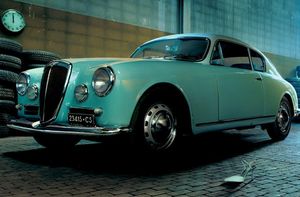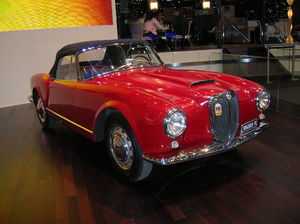.
Lancia Aurelia: Difference between revisions
Red marquis (talk | contribs) No edit summary |
Red marquis (talk | contribs) No edit summary |
||
| Line 55: | Line 55: | ||
At the rear was an innovative combination [[transaxle]] with the [[gearbox]], [[clutch]], [[differential|differential]], and [[inboard brake|inboard-mounted]] [[drum brake]]s. The front suspension was a [[sliding pillar]] design, with rear [[semi-trailing arm]]s replaced by a [[de Dion tube]] in the [[#Fourth series|Fourth series]]. | At the rear was an innovative combination [[transaxle]] with the [[gearbox]], [[clutch]], [[differential|differential]], and [[inboard brake|inboard-mounted]] [[drum brake]]s. The front suspension was a [[sliding pillar]] design, with rear [[semi-trailing arm]]s replaced by a [[de Dion tube]] in the [[#Fourth series|Fourth series]]. | ||
See Wikicars' comprehensive '''[[Wikicars:Model Review Template|<MODEL> Review]]'''. | See Wikicars' comprehensive '''[[Wikicars:Model Review Template|<MODEL> Review]]'''. | ||
| Line 325: | Line 267: | ||
===First Generation/Origins (YYYY–YYYY)=== | ===First Generation/Origins (YYYY–YYYY)=== | ||
==First series== | ==First series== | ||
The very first Aurelias were the '''B10''' [[sedan|berlinas (sedans)]]. They used a 1754 cc version of the V6 which produced 56 hp. The '''B21''' was released in 1951 with a larger 1991 cc 70 hp engine. A 2-door '''B20''' GT coupé appeared that same year. It had a shorter wheelbase and a [[Ghia]]-designed, [[Pininfarina]]-built body. The same 1991 cc engine produced 75 hp in the B20. In all, 500 first series Aurelias were produced. | The very first Aurelias were the '''B10''' [[sedan|berlinas (sedans)]]. They used a 1754 cc version of the V6 which produced 56 hp. The '''B21''' was released in 1951 with a larger 1991 cc 70 hp engine. A 2-door '''B20''' GT coupé appeared that same year. It had a shorter wheelbase and a [[Ghia]]-designed, [[Pininfarina]]-built body. The same 1991 cc engine produced 75 hp in the B20. In all, 500 first series Aurelias were produced. | ||
| Line 365: | Line 292: | ||
The sixth series B24 convertible was very similar to the fifth series, with some minor differences in trim. Most notably, the fuel tank was in the trunk, not behind the seats as it was in the fourth and fifth series open cars. This change, however, did not apply for the first 150 sixth series cars, which were like the fifth series. The sixth series convertibles also featured different seats than either both earlier cars. | The sixth series B24 convertible was very similar to the fifth series, with some minor differences in trim. Most notably, the fuel tank was in the trunk, not behind the seats as it was in the fourth and fifth series open cars. This change, however, did not apply for the first 150 sixth series cars, which were like the fifth series. The sixth series convertibles also featured different seats than either both earlier cars. | ||
==Worldwide== | |||
If the [[automobile|vehicle]] is sold in other markets worldwide, then this is the section to mention that information. Also, mention if the <MODEL> goes by another name in these other markets. | |||
==Design quirks and oddities== | |||
Refer to any pop-culture tidbits about the [[Automobile|vehicle]] in this section. | |||
==Awards== | |||
List out notable ''awards'' that the model has recieved while in production. '''Boldface''' the company or orgainization that gives out the award, and ''Italicize'' the name of the award. | |||
==See also== | |||
{{lancia}} | |||
==External Links== | |||
Please include any external sites that were used in collaborating this data, including manufacturer sites, in this section. | |||
[[Category:Lancia Vehicles|Aurelia]] | [[Category:Lancia Vehicles|Aurelia]] | ||
Revision as of 04:57, 19 June 2007

| |
| Lancia Aurelia | |
|---|---|
| Lancia | |
| aka | |
| Production | |
| Class | |
| Body Style | |
| Length | |
| Width | |
| Height | |
| Wheelbase | |
| Weight | |
| Transmission | |
| Engine | |
| Power | |
| Similar | |
| Designer | Vittorio Jano |
The Lancia Aurelia is considered by many to be the first true Gran Turismo automobile. Designed by Vittorio Jano, the Aurelia was launched in 1950 and production lasted through the summer of 1958.
The Aurelia used the first production V6 engine, a 60° design developed by de Virgilio, a Lancia engineer who worked under Jano which grew from 1.8 L to 2.5 L. It was an all-alloy pushrod design with a single camshaft between the cylinder banks. A hemispherical combustion chamber and inline valves were used. A single Weber 40 carburettor completed the engine.
At the rear was an innovative combination transaxle with the gearbox, clutch, differential, and inboard-mounted drum brakes. The front suspension was a sliding pillar design, with rear semi-trailing arms replaced by a de Dion tube in the Fourth series.
See Wikicars' comprehensive <MODEL> Review.
Recent Changes
Mention any minor facelifts or major changes made to the vehicle here.
Styles and Major Options
Certain vehicles come in different trim levels or body styles. Features and major options should be mentioned here.
Pricing
Add more fields as necessary.
|
MODEL Trims |
|||
|
Trim1 |
Trim2 |
Trim3 |
Trim4 |
|
MSRP |
|||
|
$Price1 |
$Price2 |
$Price3 |
$Price4 |
|
Invoice |
|||
|
$Price1 |
$Price2 |
$Price3 |
$Price4 |
Gas Mileage
Add more fields as necessary.
As seen on the FuelEconomy.gov website, the City/Highway MPG averages are as follows:
|
Trim |
|||
|
Trim1 |
Trim2 |
Trim3 |
Trim4 |
|
MPG |
|||
|
c/h |
c/h |
c/h |
c/h |
Reliability
Warranty options and scheduled maintainence information should be mentioned here.
Safety
This section should reference points on safety ratings and features of the vehicle.
Photos
Add Photos of the vehicle here.
Please make sure not to use copyrighted photos.
Colors
List the colors that the particular <MODEL> is offered in.
Main Competitors
Create links to other <MAKE> <MODEL> pages in this section.
Hybrid Models
If there are hybrid versions of this vehicle manufactured, then please elaborate a little bit on it here.
Unique Attributes
If there are any features of this vehicle that sets it apart from other vehicles in its class, then mention those unique attributes here.
Resale Values
Add more fields as necessary.
|
<MODEL> Year |
|||
|
Year X |
Year X-2 |
Year X-3 |
Year X-4 |
|
Resale Value |
|||
|
$ |
$ |
$ |
$ |
Criticisms
Please make sure to keep critiques in a third-person point of view. If using criticisms from a reputable automotive source, then please make sure to cite the quote.
Generations
Fill in as many as appropriate. Add more if necessary and pictures wherever applicable.
Please make sure NOT to use copyrighted pictures.
Current Generation: (YYYY–present)
Fifth generation (YYYY–YYYY)
Fourth generation (YYYY–YYYY)
Third generation (YYYY–YYYY)
Second generation (YYYY–YYYY)
First Generation/Origins (YYYY–YYYY)
First series
The very first Aurelias were the B10 berlinas (sedans). They used a 1754 cc version of the V6 which produced 56 hp. The B21 was released in 1951 with a larger 1991 cc 70 hp engine. A 2-door B20 GT coupé appeared that same year. It had a shorter wheelbase and a Ghia-designed, Pininfarina-built body. The same 1991 cc engine produced 75 hp in the B20. In all, 500 first series Aurelias were produced.
Second series
The second series Aurelia coupe pushed power up to 80 hp from the 1991 cc V6 with a higher compression ratio and repositioned valves. Other changes included better brakes and minor styling tweaks, such as chromed bumpers instead of the aluminium ones used in the earlier car. . A new dashboard featured two larger instrument gauges. The suspension was unchanged from the first series. A new B22 sedan was released in 1952 with dual Webers and a hotter camshaft for 90 hp.
Third series
The third series appeared in 1953 with a larger 2451 cc version of the engine. The rear of the car lost the tailfins of the earlier series, but was well resolved in a definitive look for the Aurelia coupe.
Fourth series
The fourth series introduced the new de Dion tube rear suspension. The engine was changed from white metal bearings to shell bearings. An open car, the B24 Spider was introduced at this time (1954 to 1955) and was well received. It was similar to the B20 coupé mechanically, with an 8 inch shorter wheelbase than the coupé.
The fourth series cars were the first Aurelias to be available in left-hand drive; fourth series Aurelias were the first ones to be imported to the US in any number.
Fifth series
The fifth series coupé, appearing in 1956, was more luxury-oriented. It had a different transaxle (split case), which was more robust and similar to that used in the later Flaminias. The driveshaft was also revised to reduce vibration.
Alongside the fifth series coupés was a revised open car, the B24 convertible. This differed from the earlier B24 Spider, having roll-up windows, better seating position, and a windscreen with vent windows. In mechanical aspects, the B24 convertible was similar to the coupe of the same series.
Sixth series
Power was down to 112 hp for the 1957 sixth series, with increased torque to offset the greater weight of the later car. The sixth series coupés had vent windows, and typically a chrome strip down the hood. They were the most touring oriented of the B20's.
The sixth series B24 convertible was very similar to the fifth series, with some minor differences in trim. Most notably, the fuel tank was in the trunk, not behind the seats as it was in the fourth and fifth series open cars. This change, however, did not apply for the first 150 sixth series cars, which were like the fifth series. The sixth series convertibles also featured different seats than either both earlier cars.
Worldwide
If the vehicle is sold in other markets worldwide, then this is the section to mention that information. Also, mention if the <MODEL> goes by another name in these other markets.
Design quirks and oddities
Refer to any pop-culture tidbits about the vehicle in this section.
Awards
List out notable awards that the model has recieved while in production. Boldface the company or orgainization that gives out the award, and Italicize the name of the award.
See also
Error creating thumbnail: Unable to save thumbnail to destination
| ||
| LANCIA | ||
|
Abarth | Alfa Romeo | Autobianchi | Ferrari | Fiat | Lancia | Innocenti | Maserati | Iveco | Chrysler | Dodge | Ram | Jeep 1907–1918: Alfa-12HP · Dialfa-18HP · Beta-15/20HP · Delta-20/30HP · Epsilon · Eta-30/50HP · Gamma-20HP · Theta-35HP · Zeta-12/15HP 1918-1945: Aprilia · Ardea · Artena · Astura · Augusta · Dilambda · Kappa · Dikappa · Lambda · Trikappa 1945-1980: Appia · Aurelia · Beta · D20 · D23 · D24 · D25 · D50 · Flaminia · Flavia · 2000 · Fulvia · Gamma · Montecarlo · Stratos HF 1980-2006: Dedra · Delta S4 · Kappa · LC1 · LC2 · Lybra · Prisma · Thema · Thema 8.32 · Trevi · Y10 · Ypsilon · Zeta · 037 (Group B) Current models: Musa · Phedra · Thesis · Ypsilon · Delta Rally cars: 037 · Stratos Rally Car · Delta HF Integrale Rally Car Concept: Fulvia Concept · Delta HPE Concept · Stratos Zero Concept Include notable internal links here | ||
| Vincenzo Lancia | Corporate website | A brand of the Fiat group |
External Links
Please include any external sites that were used in collaborating this data, including manufacturer sites, in this section.

